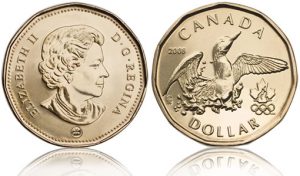 Yesterday’s trade (in GMT terms) saw USD/CAD within the range of 1.2862-1.2976. The pair closed at 1.2893, shedding 0.65% compared to Tuesdays close. It has been the 136th drop in the past 294 trading days and also a third consecutive one. The daily low has been the lowest level since July 5th, when a low of 1.2839 was registered. The major pair has neutralized earlier gains and is now down 0.28% so far during the current month, following a 1.29% slump in June.
Yesterday’s trade (in GMT terms) saw USD/CAD within the range of 1.2862-1.2976. The pair closed at 1.2893, shedding 0.65% compared to Tuesdays close. It has been the 136th drop in the past 294 trading days and also a third consecutive one. The daily low has been the lowest level since July 5th, when a low of 1.2839 was registered. The major pair has neutralized earlier gains and is now down 0.28% so far during the current month, following a 1.29% slump in June.
At 8:23 GMT today USD/CAD was inching down 0.04% on the day to trade at 1.2888. The pair touched a daily high at 1.2920 during mid-Asian trade, undershooting the range resistance level (R3), and a daily low at 1.2877 during the early phase of the Asian trading session.
Meanwhile, crude oil futures marked their 69th gain out of the past 149 trading days on July 14th. Oil for August delivery went up as high as $45.80 per barrel and closed at $45.68, surging 2.08% compared to Wednesday’s close. As of 8:31 GMT today the commodity was retreating 1.12% to trade at $45.17, after going down as low as $45.05 per barrel earlier.
On Friday USD/CAD trading may be influenced by the following macroeconomic reports as listed below.
Fundamentals
United States
Consumer Inflation
The annualized consumer inflation in the United States probably accelerated to 1.1% in June, according to market expectations, from 1.0% in May. In monthly terms, the Consumer Price Index (CPI) probably rose for a fourth consecutive month in June, going up 0.3%, according to the market consensus, following a 0.2% surge in the preceding month.
In May, cost of food rose at an annual rate of 0.7%, following a 0.9% surge in April, cost of transportation services went up 3.2% year-on-year, decelerating from a 3.3% increase in April, while cost of energy dropped 10.1%, accelerating from an 8.9% drop in the preceding month, according to the report by the Bureau of Labor Statistics. On the other hand, cost of services less energy rose at an annualized rate of 3.2% in May, accelerating from a 3.0% surge in the prior month, cost of shelter went up 3.4%, following a 3.2% increase in April, while cost of medical care soared 3.5% year-on-year, following a 3.1% increase in April.
The annualized core consumer inflation, which is stripped of prices of food and energy, probably accelerated to 2.3% in June, according to market expectations, from 2.2% in May. If expectations were met, this would be the highest annual core inflation since February.
If the general CPI tends to approach the inflation objective, set by the Federal Reserve and considered as providing price stability, or a level below but close to 2%, this will usually bolster the appeal of the US dollar, as it heightens the probability of monetary policy tightening.
The Bureau of Labor Statistics is to release the official CPI report at 12:30 GMT.
Retail Sales
Retail sales in the United States probably rose for a third straight month in June, going up at a monthly rate of 0.1%, according to the median forecast by experts, following a 0.5% surge in May.
Among the 13 major categories, 9 registered growth and 4 registered a decline in May. During the period, a decrease in sales was registered at in building material & garden equipment and supplies dealers (-1.8%), miscellaneous store retailers (-1.2%), general merchandise stores (-0.3%) and furniture and home furniture stores (-0.1%).
On the other hand, in May, retail sales went up at gasoline stations (2.1%), sporting goods, hobby, book & music stores (1.3%), non-store retailers (1.3%), food services and drinking places (0.8%), clothing and clothing accessories stores (0.8%), health and personal care stores (0.6%), motor vehicle and part dealers (0.5%), food and beverage stores (0.5%) and electronics and appliance stores (0.3%), according to the report by the US Census Bureau.
Annualized retail sales increased 2.5% in May, following a 3.0% climb in April.
US core retail sales, or retail sales ex autos, probably rose 0.4% in June compared to a month ago, according to expectations, following another 0.4% gain in May. If so, it would be a fourth consecutive month of increase. This indicator removes large ticket prices and historical seasonality of automobile sales.
In case the general index of sales rose at a steeper rate than anticipated in June, this would have a strong bullish effect on the US dollar. The official report by the US Census Bureau is due out at 12:30 GMT.
Industrial Production
Industrial output in the United States probably expanded at a monthly rate of 0.2% in June, according to market expectations, following a 0.4% contraction in the prior month.
In May output in the US mining sector rose 0.2% month-over-month, following 8 successive months of contraction, as coal mining rebounded, while non-metallic mineral mining continued to expand.
The gauge for utilities registered a 1.0% monthly decrease in May, as lower output of electric utilities was partly neutralized by a surge in natural gas utilities.
Manufacturing production, which accounts for almost three quarters of total industrial production, shrank 0.4% in May, as production of durables contracted 0.7%, that of non-durables was little changed, while other manufacturing (publishing and logging) declined 0.6%.
In case the index of production expanded more than anticipated in June, this would have a moderate bullish effect on the US Dollar, because of positive implications regrading inflation pressure and overall economic activity, respectively. The Board of Governors of the Federal Reserve is to release the production data at 13:15 GMT.
Reuters/Michigan Consumer Sentiment Index – preliminary reading
The monthly survey by Thomson Reuters and the University of Michigan may show that consumer confidence in the United States remained unchanged in July. The preliminary reading of the corresponding index, which usually comes out two weeks ahead of the final data, probably remained at 93.5 during the current month, matching the final reading in June. The latter came below the preliminary reading of 94.3, which was reported on June 10th.
The sub-index of current economic conditions dropped to a final reading of 110.8 in June from a preliminary value of 111.7. In May this barometer was reported at a final 109.9.
The sub-index of consumer expectations came in at a reading of 82.4, down from a preliminary value of 83.2 in June, and down from a final reading of 84.9 registered in May.
Participants in the June survey expected that the rate of inflation will be at 2.4% during the next year, or unchanged from the preliminary release and from the May survey.
In case the gauge of consumer sentiment came above expectations in July, this would have a moderate-to-strong bullish effect on the US Dollar. The preliminary reading is due out at 14:00 GMT.
Canada
Manufacturing Shipments
Manufacturing sales in Canada probably shrank in May, going down at a monthly rate of 0.7%, according to market expectations. In April compared to March shipments were 1.0% higher. The Monthly Survey of Manufacturing features statistical data regarding sales of finished goods, inventories, unfilled orders and new orders in Canadas sector of manufacturing. About 10 500 items and 27 000 companies are encompassed.
Manufacturing sales are considered as an indicator of demand in the future. A decrease in the number of goods and unsold inventories suggests, that demand is sufficient and vice versa. At the same time, a decrease in sales (shipments) suggests a weaker demand. Therefore, in case shipments fell at a faster pace than anticipated, this might have a limited-to-moderate bearish effect on the Canadian dollar. Statistics Canada will release the official report at 12:30 GMT.
Bond Yield Spread
The yield on Canada’s 2-year government bonds went as high as 0.547% on July 14th, or the highest level since June 30th (0.558%), after which it closed at 0.546% to add 5.1 basis points (0.051 percentage point) compared to July 13th.
Meanwhile, the yield on US 2-year government bonds climbed as high as 0.701% on July 14th, or the highest level since June 24th (0.755%), after which it fell to 0.669% at the close to add 0.004 percentage point compared to July 13th.
The spread between 2-year US and 2-year Canadian bond yields, which reflects the flow of funds in a short term, narrowed to 0.123% on July 14th from 0.170% on July 13th. The July 14th yield spread has been the lowest one since July 6th, when the difference was 0.096%.
Daily, Weekly and Monthly Pivot Levels
By employing the Camarilla calculation method, the daily levels of importance for USD/CAD are presented as follows:
R1 – 1.2903
R2 – 1.2914
R3 (Range Resistance – Sell) – 1.2924
R4 (Long Breakout) – 1.2956
R5 (Breakout Target 1) – 1.2992
R6 (Breakout Target 2) – 1.3007
S1 – 1.2883
S2 – 1.2872
S3 (Range Support – Buy) – 1.2862
S4 (Short Breakout) – 1.2830
S5 (Breakout Target 1) – 1.2794
S6 (Breakout Target 2) – 1.2779
By using the traditional method of calculation, the weekly levels of importance for USD/CAD are presented as follows:
Central Pivot Point – 1.2987
R1 – 1.3147
R2 – 1.3250
R3 – 1.3410
R4 – 1.3570
S1 – 1.2884
S2 – 1.2724
S3 – 1.2621
S4 – 1.2518
In monthly terms, for USD/CAD we have the following pivots:
Central Pivot Point – 1.2907
R1 – 1.3163
R2 – 1.3401
R3 – 1.3657
R4 – 1.3913
S1 – 1.2669
S2 – 1.2413
S3 – 1.2175
S4 – 1.1937





